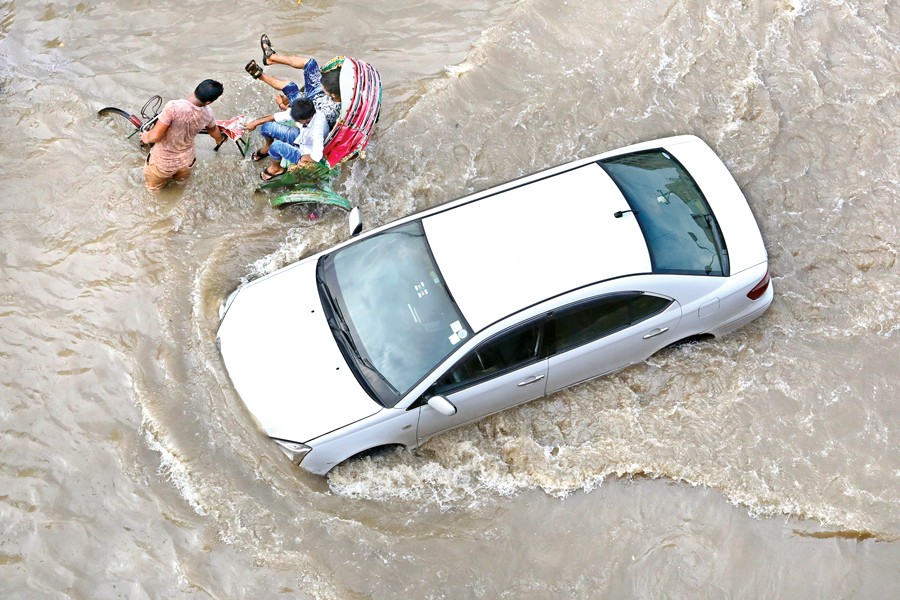
Published :
Updated :

In spite of the season being monsoon, the torrential rains on the days before and after Eid-ul-Azha were least expected. Following the rainless, sultry days for nearly two weeks, the residents of Dhaka were wistfully awaiting a cool weather accompanied by normal spells of rain. They were not prepared for the heavy monsoon showers that detracted lot from the Eid jubilations. As seen in the last couple of years, the residents of Dhaka had already started viewing themselves free of the capital's perennial scourge of water-logging. The reemergence of the urban affliction during the Eid holidays made many feel dejected. The feeling of gloom was prompted by rainwater-flooded main roads and lanes in different neighbourhood, conventionally termed waterlogged areas.
Those included a number of city areas that eventually emerged as metonymy for Dhaka's urban inundation. Year in and year out, the roads and footpaths in these large swatheswould go under knee- deep water following long bouts of rain. The water-logging compelled both motorised and non-motorised vehicles to move through submerged roads during monsoon almost every year. After repeated phases of repairs and renovation, a few of these premier roads proved to be tolerably water-logging-proof. In most cases, however, they have relapsed to their earlier plight. Roads in Kazipra and Shewrapara and some other areas in Mirpur stand proof to this unpalatable reality. In the northern and western parts of Dhaka, dozens of major roads have yet to emerge fully free of the assaults of the monsoon rains. Besides, parts of Mohammadpur and MerulBadda and many areas on the city outskirts still remain vulnerable to water-logging. Tospeak pithily, except some exclusive areas, veritably it is the whole metropolis which has started falling victim to big and small road inundations.
The roads which had to take in the biggest load of water-logging are those situated in the city's older part. Apart from the relatively wider ones, dozens of lanes and by-lanes in Old Dhaka remain under water for days, and even weeks. Experts blame weak waste and drainage management jobs for this plight of the roads and the areas adjacent to them in the city's older part. In order to remain free of the water-logging of roads and low-lying areas the authorities concerned have been putting in place technical measures one after another for long. Laying storm sewage lines and placing box culverts are among them. According to people aware of the problems, the system of box culverts resulted in a mess. The storm sewage lines have also failed to come up to the expectation. Given these stark realities, how far the different water-logging prevention steps will work is anybody's guess.
In the meantime, the civil society involved with the movements for making Dhaka a livable city has long been advocating the demand for restoring the long choked canals. They believe by reviving the fast disappearing canals, the waste-filled putrid rain waters could be made to flow into the Buriganga and its three branches. In the case of any dawdling, the existing canals might meet the fate of the now extinct DolaiKhaal. The 26 'restored' canals of Dhaka can play a great role in keeping Dhaka free of monsoon flooding and the yearly menace of water-logging. The case of Chattogram is similar to that of Dhaka, as it, too, has a 'now-dysfunctional' large canal network. Of late, the water-logging menace has started bringing a lot of miseries for the port city's people. Instead of taking pompous projects, the authorities of the two cities should also concentrate on their dying canals.


 For all latest news, follow The Financial Express Google News channel.
For all latest news, follow The Financial Express Google News channel.